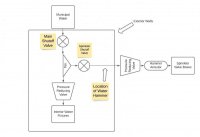I'm at a loss - I've tried everything I can think of, so its time to turn to the experts. I've attached a rudimentary schematic to help you understand the general layout of things.
My House is up on a hill, so the street (including municipal water) is probably 15-20 vertical feet below the main floor. Water comes into the house from the street to the basement where I have a main shutoff valve. It then goes up to the ceiling of the basement and tees off to the sprinkler shutoff valve in one direction with the other direction going to the pressure reducing valve and then on to all the fixtures in the house (see image)
When I turn ON a sprinkler station (it doesn't matter which one), I get a violent hammer sound coming from the pipe inside the house that feeds the sprinklers. Sometimes its just loud and scary, but in the fall (not sure why it would be worse in Sept-October) it is clearly dangerous because it causes the walls of my house to shake. It only lasts 5 seconds or so. Subsequent valves don't produce the same result, its always just the first one.
Last year I had the hammer arrestor installed, but it didn't help. This spring I had the Pressure Reducing Valve installed (On the line going to the sprinkler valves) and I've tried lowering the pressure, but the hammer always comes back and I can only lower it so much considering that water is already traveling pretty far uphill to get to the yard.
Last year I also put a foam sleeve around the pipe that is hammering, but that hasn't helped. We now have drywall and insulation in the basement, so I'm not able to access any of the interior parts anymore other than the shutoff valves.
I'm not a plumber or an engineer, but my understanding is that hammer usually occurs when a valve is closed - this only happens when the sprinkler valves open which I guess maybe suggests air in the valves? or is it just that the velocity is changing so quickly? I can't really adjust the solenoids on my valves to open slower, can I?
Any help is greatly appreciated. Sprinklers are probably done for the year, but I'd like to have a plan for next year before we get to it.
My House is up on a hill, so the street (including municipal water) is probably 15-20 vertical feet below the main floor. Water comes into the house from the street to the basement where I have a main shutoff valve. It then goes up to the ceiling of the basement and tees off to the sprinkler shutoff valve in one direction with the other direction going to the pressure reducing valve and then on to all the fixtures in the house (see image)
When I turn ON a sprinkler station (it doesn't matter which one), I get a violent hammer sound coming from the pipe inside the house that feeds the sprinklers. Sometimes its just loud and scary, but in the fall (not sure why it would be worse in Sept-October) it is clearly dangerous because it causes the walls of my house to shake. It only lasts 5 seconds or so. Subsequent valves don't produce the same result, its always just the first one.
Last year I had the hammer arrestor installed, but it didn't help. This spring I had the Pressure Reducing Valve installed (On the line going to the sprinkler valves) and I've tried lowering the pressure, but the hammer always comes back and I can only lower it so much considering that water is already traveling pretty far uphill to get to the yard.
Last year I also put a foam sleeve around the pipe that is hammering, but that hasn't helped. We now have drywall and insulation in the basement, so I'm not able to access any of the interior parts anymore other than the shutoff valves.
I'm not a plumber or an engineer, but my understanding is that hammer usually occurs when a valve is closed - this only happens when the sprinkler valves open which I guess maybe suggests air in the valves? or is it just that the velocity is changing so quickly? I can't really adjust the solenoids on my valves to open slower, can I?
Any help is greatly appreciated. Sprinklers are probably done for the year, but I'd like to have a plan for next year before we get to it.

